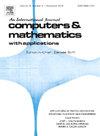On the use of exponential basis functions in the PINN architecture: An enhanced solution approach for the Laplace, Helmholtz, and elasto-static equations
IF 2.9
2区 数学
Q1 MATHEMATICS, APPLIED
引用次数: 0
Abstract
This paper presents a novel physics-informed neural network (PINN) architecture that employs exponential basis functions (EBFs) to solve many boundary value problems. The EBFs are organized so that the PINN architecture may employ their simple differentiation features to solve partial differential equations (PDEs). The proposed approach has been meticulously investigated and compared to the conventional PINN in the solution of many instances involving Laplace and Helmholtz differential equations, as well as linear and nonlinear elasto-static problems. By utilizing EBFs, fewer interpolation functions are needed and the derivation rule can be explicitly applied, significantly reducing computation time. In addition, in some problems, PINN embedded with EBFs shows better precision near the boundaries of the problem, which is one of the disadvantages of conventional PINNs. Two specific applications of the presented method have been investigated, namely the inverse identification of material properties and the solution of complex-valued partial differential equations. The proposed method was found to be accurate and converging when applied to inverse problems. As shown, it is also suitable for the solution of PDEs containing both imaginary and real parts.
在PINN体系结构中使用指数基函数:拉普拉斯、亥姆霍兹和弹性静力方程的增强解方法
本文提出了一种新的物理信息神经网络(PINN)结构,该结构采用指数基函数(EBFs)来解决许多边值问题。ebf的组织使得PINN架构可以利用它们的简单微分特征来求解偏微分方程(PDEs)。在许多涉及拉普拉斯和亥姆霍兹微分方程以及线性和非线性弹性静力问题的实例的解决中,所提出的方法已被仔细研究并与传统的PINN进行了比较。利用ebf可以减少插值函数的使用,并且可以显式地应用推导规则,大大减少了计算时间。此外,在某些问题中,嵌入ebf的PINN在问题边界附近显示出更好的精度,这是传统PINN的缺点之一。研究了该方法的两种具体应用,即材料性质的逆识别和复值偏微分方程的求解。结果表明,该方法具有较好的收敛性和准确性。如图所示,它也适用于包含虚部和实部的偏微分方程的解。
本文章由计算机程序翻译,如有差异,请以英文原文为准。
求助全文
约1分钟内获得全文
求助全文
来源期刊

Computers & Mathematics with Applications
工程技术-计算机:跨学科应用
CiteScore
5.10
自引率
10.30%
发文量
396
审稿时长
9.9 weeks
期刊介绍:
Computers & Mathematics with Applications provides a medium of exchange for those engaged in fields contributing to building successful simulations for science and engineering using Partial Differential Equations (PDEs).
 求助内容:
求助内容: 应助结果提醒方式:
应助结果提醒方式:


